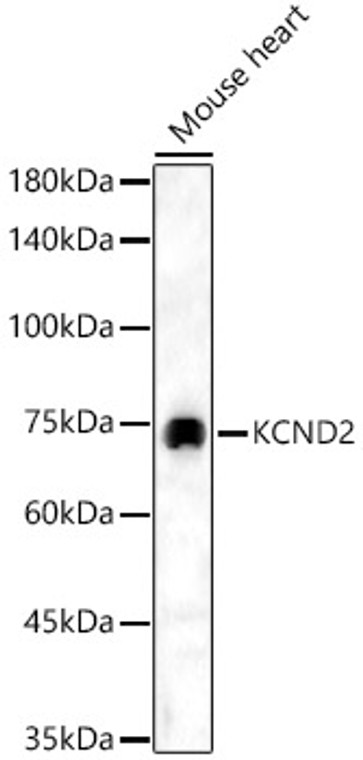| Host: |
Rabbit |
| Applications: |
WB |
| Reactivity: |
Mouse |
| Note: |
STRICTLY FOR FURTHER SCIENTIFIC RESEARCH USE ONLY (RUO). MUST NOT TO BE USED IN DIAGNOSTIC OR THERAPEUTIC APPLICATIONS. |
| Short Description: |
Rabbit polyclonal antibody anti-KCND2 (501-630) is suitable for use in Western Blot research applications. |
| Clonality: |
Polyclonal |
| Conjugation: |
Unconjugated |
| Isotype: |
IgG |
| Formulation: |
PBS with 0.02% Sodium Azide, 50% Glycerol, pH7.3. |
| Purification: |
Affinity purification |
| Dilution Range: |
WB 1:1000-1:5000 |
| Storage Instruction: |
Store at-20°C for up to 1 year from the date of receipt, and avoid repeat freeze-thaw cycles. |
| Gene Symbol: |
KCND2 |
| Gene ID: |
3751 |
| Uniprot ID: |
KCND2_HUMAN |
| Immunogen Region: |
501-630 |
| Immunogen: |
Recombinant fusion protein containing a sequence corresponding to amino acids 501-630 of human KCND2 (NP_036413.1). |
| Immunogen Sequence: |
ESCMEVATVNRPSSHSPSLS SQQGVTSTCCSRRHKKTFRI PNANVSGSHQGSIQELSTIQ IRCVERTPLSNSRSSLNAKM EECVKLNCEQPYVTTAIISI PTPPVTTPEGDDRPESPEYS GGNIVRVSAL |
| Tissue Specificity | Detected in ovary, in corpus luteum and in granulosa and theca cells in the follicle (at protein level). Highly expressed throughout the brain. Detected in amygdala, caudate nucleus, cerebellum, hippocampus, substantia nigra and thalamus. Expression is not detectable or very low in heart, kidney, liver, lung, pancreas and skeletal muscle. Not detectable in human heart atrium. |
| Post Translational Modifications | Phosphorylation at Ser-438 in response to MAPK activation is increased in stimulated dendrites. Interaction with KCNIP2 and DPP6 propomtes phosphorylation by PKA at Ser-552. Phosphorylation at Ser-552 has no effect on interaction with KCNIP3, but is required for the regulation of channel activity by KCNIP3. Phosphorylation at Ser-552 leads to KCND2 internalization. Phosphorylated by MAPK in response to signaling via the metabotropic glutamate receptor GRM5. Phosphorylation at Ser-616 is required for the down-regulation of neuronal A-type currents in response to signaling via GRM5. |
| Function | Voltage-gated potassium channel that mediates transmembrane potassium transport in excitable membranes, primarily in the brain. Mediates the major part of the dendritic A-type current I(SA) in brain neurons. This current is activated at membrane potentials that are below the threshold for action potentials. It regulates neuronal excitability, prolongs the latency before the first spike in a series of action potentials, regulates the frequency of repetitive action potential firing, shortens the duration of action potentials and regulates the back-propagation of action potentials from the neuronal cell body to the dendrites. Contributes to the regulation of the circadian rhythm of action potential firing in suprachiasmatic nucleus neurons, which regulates the circadian rhythm of locomotor activity. Functions downstream of the metabotropic glutamate receptor GRM5 and plays a role in neuronal excitability and in nociception mediated by activation of GRM5. Mediates the transient outward current I(to) in rodent heart left ventricle apex cells, but not in human heart, where this current is mediated by another family member. Forms tetrameric potassium-selective channels through which potassium ions pass in accordance with their electrochemical gradient. The channel alternates between opened and closed conformations in response to the voltage difference across the membrane. Can form functional homotetrameric channels and heterotetrameric channels that contain variable proportions of KCND2 and KCND3.channel properties depend on the type of pore-forming alpha subunits that are part of the channel. In vivo, membranes probably contain a mixture of heteromeric potassium channel complexes. Interaction with specific isoforms of the regulatory subunits KCNIP1, KCNIP2, KCNIP3 or KCNIP4 strongly increases expression at the cell surface and thereby increases channel activity.it modulates the kinetics of channel activation and inactivation, shifts the threshold for channel activation to more negative voltage values, shifts the threshold for inactivation to less negative voltages and accelerates recovery after inactivation. Likewise, interaction with DPP6 or DPP10 promotes expression at the cell membrane and regulates both channel characteristics and activity. |
| Protein Name | Potassium Voltage-Gated Channel Subfamily D Member 2Voltage-Gated Potassium Channel Subunit Kv4.2 |
| Database Links | Reactome: R-HSA-1296072Reactome: R-HSA-5576894 |
| Cellular Localisation | Cell MembraneMulti-Pass Membrane ProteinCell ProjectionDendriteSynapsePerikaryonPostsynaptic Cell MembraneDendritic SpineCell JunctionIn NeuronsPrimarily Detected On DendritesDendritic Spines And On The Neuron Cell BodyBut Not On AxonsLocalized Preferentially At The Dendrites Of Pyramidal Cells In The Hippocampus Ca1 LayerDetected At Gabaergic SynapsesDetected At Cell Junctions That Are Distinct From Synaptic Cell ContactsDetected In Lipid RaftsDetected Primarily At The Endoplasmic Reticulum Or Golgi When Expressed By ItselfInteraction With Kcnip1Kcnip2Kcnip3 Or Kcnip4 Promotes Expression At The Cell MembraneInteraction With Dpp6 Or Dpp10 Promotes Expression At The Cell MembraneInternalized From The Cell Membrane By Clathrin-Dependent Endocytosis In Response To Activation Of Ampa-Selective Glutamate Receptors And Pka-Mediated Phosphorylation At Ser-552Redistributed From Dendritic Spines To The Main Dendritic Shaft In Response To Activation Of Ampa-Selective Glutamate Receptors And Activation Of Pka |
| Alternative Antibody Names | Anti-Potassium Voltage-Gated Channel Subfamily D Member 2 antibodyAnti-Voltage-Gated Potassium Channel Subunit Kv4.2 antibodyAnti-KCND2 antibodyAnti-KIAA1044 antibody |
Information sourced from Uniprot.org
12 months for antibodies. 6 months for ELISA Kits. Please see website T&Cs for further guidance







